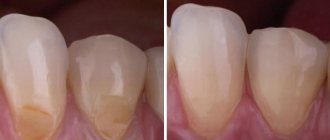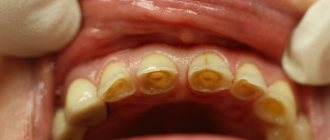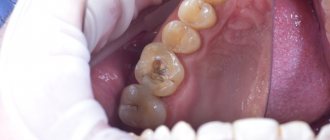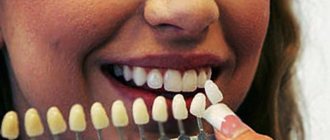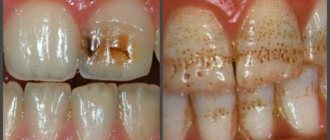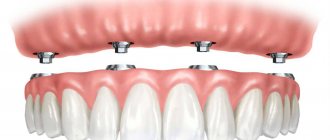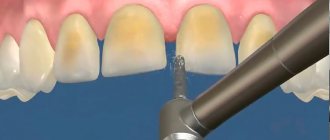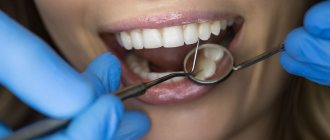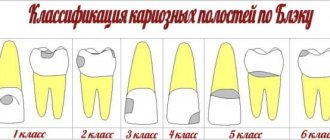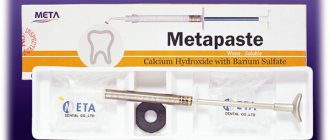Classification of composites in dentistry
Composites used in dentistry are multiphase compositions. They vary in degree of viscosity. The main functions performed by composites or photocomposites in dentistry are therapeutic and aesthetic. They gained popularity due to their plasticity, which is combined with strength.
The classification of these dental products is large and complex. This is due to the variety of dental composites available. They differ in the components in the composition, in the size of the filler, in function and other indicators. For example, different types of teeth will be used depending on their function. There are composites that are intended for the treatment of front teeth and lateral teeth necessary for chewing food. There are formulations that are suitable for all teeth.
What determines the price of a chemical composite filling?
The cost of installation is calculated by the dentist after examination and diagnosis. It depends on:
- the degree of tooth decay and the need to use additional means (for example, linings for caries);
- area of location of the affected dental unit;
- pricing policy of the dental clinic and the level of qualification of the dentist.
You can make an appointment with CELT dentists online or by contacting our information line operators.
Make an appointment through the application or by calling +7 +7 We work every day:
- Monday—Friday: 8.00—20.00
- Saturday: 8.00–18.00
- Sunday is a day off
The nearest metro and MCC stations to the clinic:
- Highway of Enthusiasts or Perovo
- Partisan
- Enthusiast Highway
Driving directions
The basis of composites in dentistry
Composite materials in dentistry consist of three components:
- Organic matrix;
- Inorganic filler (at least half of the total mass);
- Silane (silicon hydride, connects the first and second components).
The matrix, or matrix, is the main component of the composite, its base. The quality of the product depends on the base: compatibility with the patient’s body, flexibility, strength of fixation. The matrix is responsible for maintaining the desired shade and volume. The basis is polymer resins, for example, bisphenol glycidyl methacrylate or urethane dimethyl methacrylate. The resin does not perform all functions on its own, but uses auxiliary substances:
- Polymerization inhibitors – extend service life;
- Catalysts – begin polymerization;
- Co-catalysts and photoinitiators – promote curing;
- UV absorbers - retain color.
What are composites made of in dentistry?
The material that acts as a base is supplemented with particles (filler). The filler is mixed with the matrix. Particles differ in type, size and configuration, depending on this the properties of the resulting mixture change. The type of particles affects how the filling appears on an X-ray, how it absorbs liquid, resists physical impact, and so on. The particles can be made of glass, silica, titanium zirconium silicate, quartz, heavy salts or oxides of various metals.
The composition of the composites also includes silane. It performs two functions. It is a binder between filler particles and the matrix of composite materials in dentistry. If silane is present in a composite, it is different from other materials such as plastics.
Properties of compomers
Compomers combine the positive properties of glass ionomers and aluminosilicate glass. In fact, it is a combination in the form of photopolymerizable composites and glass ionomer polymers, characterized by color fastness, high aesthetics and ease of application. Biological compatibility is good, as is adhesion to dentin tissue. The composition includes fluorine, which has protective and preventive functions.
Properties:
- single-component composition;
- chemical adhesion;
- the total shrinkage of the mass is small;
- high aesthetics;
- cumulative effect due to fluoride content;
- biological compatibility;
- solubility in natural oral fluids is low;
- the surface is polished after installation;
- the level of expansion is close to that of tooth tissue;
- Curing requires two steps - exposure to light and absorption of natural oral fluids.
Qualities of composite filling materials
In order to choose the right composition, you need to know what qualities it has:
- Resistance to compression or tension. Can vary from 220 to 450 MPa, influenced by how heavily the material is filled.
- Resists wear. Depends on particle size.
- Color preservation.
- Visibility on X-ray. Can be 130–350%.
- The degree of shrinkage during hardening. Varies from 1.6 to 5.5%.
- Conversion of material density under the influence of mechanical load. Without external influence, the viscosity should increase.
- Thermal expansion. It is required to match the expansion natural to the tooth.
- Flexibility, the ability to change shape when compressed or stretched.
- Compatibility with the patient's body, taking into account international standards (ISO).
- Comfort when working, the ability to quickly complete a task with minimal effort.
- Appearance – the ability to choose the desired color, create a natural coating.
Tempo – the success of temporary restorations
The Tempo line includes 2 composites: Tempofot - a light-curing material for temporary fillings and Tempokor - for the manufacture of temporary crowns, inlays, onlays, and bridges.
Tempofot
This light-curing composite is available in the form of a paste and is used as a temporary filling material for isolating cavities under an inlay or coating a drug in a tooth cavity. It contains DUDMA, fine filler, light-curing activators; stabilizers; technological additives providing optimal consistency; benzalkonium chloride, which has a bactericidal effect against bacteria and fungi of the genus Candida.
After curing, TempoFot paste acquires a hard-elastic state and sufficient strength. These properties, on the one hand, ensure the stability of the filling for the period of temporary filling and, at the same time, allow the material to be easily and without residue removed from the cavity. Tempofot is easy to use and can be easily applied into the cavity with a syringe. The material is transparent, has a light shade, therefore it is cured with a halogen or LED lamp to a great depth (5 mm in 30–40 seconds). After curing, it remains elastic - the remaining material is easily and simply removed from the cavity with a probe. Tempofot guarantees the tightness of the cavity and protection from microbial contamination and contamination by food debris.
Tempokor
This chemically cured composite material based on multifunctional methacrylates is used for the manufacture of temporary orthopedic structures: crowns, inlays, onlays, and bridges. Available in the form of 2 pastes - base and catalytic, which are mixed in equal quantities before use. Has 5 shades on the VITA scale (A2, A3, A3.5, B2, C2). It cures in 5–9 minutes without overheating the tooth tissue to form a durable material that does not release monomers. Characterized by high fracture strength and resistance to abrasive influences, it ensures precise edge fit. The material has excellent polishability and long-term color stability. The shape of the orthopedic structure made by Tempokor is easily adjusted with flowable composites. Filling the mold with the material and placing it in the oral cavity takes no more than 45 seconds, curing and removal from the oral cavity takes 45 seconds to 3 minutes, and complete curing and final processing lasts 7-9 minutes.
Reliable adhesion with Belabond
Belabond adhesives are available in two versions: light and chemical curing, each of which ensures a strong connection of composite restoration materials with hard tooth tissues.
The light-curing adhesive consists of methacrylate oligomers (HEMA, UDMA), polymerization activators and stabilizers. It is capable of forming chemical bonds with tooth tissues and forming retention polymer strands in dentinal tubules.
Available as a two-component (primer and adhesive) or one-component (requires pre-etching) system, as well as in the form of a self-etching adhesive. This form of Belabond adhesive does not require preliminary etching of the enamel and easily penetrates the surface “smeared” layer of dentin, partially dissolving it. Since the processes of conditioning and diffusion occur simultaneously, the infiltration of monomers exactly corresponds to the depth of demineralization of the hard tissues of the tooth.
Light-curing belabond adhesives provide strong adhesion and reliable marginal sealing, reducing the risk of recurrent bacterial infection. They can be used with any light-curing composite materials.
The VladMiVa company also offers Belabond chemical-curing adhesive. It contains methacrylate oligomers, polymerization activators and stabilizers. Available in the form of 2 liquids (base and catalytic), the kit also includes an etching gel. This adhesive has a high chemical affinity for both composite restorative materials and hard tooth tissues and ensures a reliable marginal seal.
Compofix - fixation master
Composite cement of dual (chemical and light) curing Kompofix is used for permanent fixation of orthopedic structures: metal and metal-ceramic crowns, stump inlays made of metal alloys, ceramics and composites, veneers made of porcelain and composites, bridges.
The basis of the material is methacrylate oligomers with the addition of finely dispersed modified filler.
Main properties of Kompofix:
- working time 2–2.5 minutes;
- curing time at a temperature of 37ºС – 4 minutes;
- curing time during photopolymerization – 40 s;
- film thickness – less than 25 microns;
- bending strength – 85 MPa.
Cement allows you to use the advantages of adhesive systems and obtain excellent aesthetic results when fixing non-metallic structures (crowns, inlays, onlays, veneers). It has sufficient transparency and optimal fluidity, which makes the process of placing a restoration convenient and comfortable for the doctor and patient. The adhesive system and silane included in its composition ensure a strong connection of the composite cement with the hard tissues of the tooth and the surface of orthopedic structures.
Armo - the highest strength of transparent fiberglass
The VladMiVa company offers dentists fiberglass materials:
intracanal radiopaque fiberglass pins Armodent and fiberglass Armosplint for splinting mobile teeth.
Armodent pins are used to restore and strengthen the tooth crown after endodontic treatment (it is recommended to use them immediately after pulp removal). They are made from woven fiberglass bonded with Bis-GMA and reinforced with pyrogenic silica. The pins create reliable support for the restoration, help redistribute mechanical loads, reducing the risk of tooth splitting. The chemical affinity of their oligomeric matrix to composite materials enhances adhesion and ensures the solidity of the orthopedic structure. It is important that the modulus of elasticity of Armodent pins is close to that of dentin. Pins with a diameter of 1, 1.2 and 1.4 mm are available.
The light transmittance of fiberglass allows the use of light-curing or dual-curing materials to secure the pins.
In addition, transparent fibers do not need to be masked when restoring teeth in aesthetically significant areas.
Armosplint fiberglass reinforcing tape is used for coronal and intracoronal fixation of moving teeth, ensuring tooth retention when consolidating the results of orthodontic treatment, and immobilizing a tooth in case of traumatic dislocation or subluxation. Armosplint can also be used when replacing dental defects using the direct method, restoring the coronal part of the tooth, manufacturing adhesive dentures and splinting structures using the indirect method (in a dental laboratory).
Flexible fiberglass adapts well to uneven tooth surfaces, so gentle preparation is sufficient at the preparatory stage. Fiberglass is compatible with any flowable composites, can be easily sanded off if accidentally exposed, is moisture resistant, and hypoallergenic (in most cases). Does not require special storage conditions, working with special gloves or using special tools. It can be cut with ordinary sharp scissors and will not unravel.
Varnish Axil LC – reliable protection of restorations
Protective light-curing varnish Axil LC is designed to protect fillings made of glass ionomer cements from moisture, eliminate minor defects and porosity on the surface of composite restorations. The material contains methacrylate oligomers, solvent, initiators and stabilizers. Axil LC has good adhesion to filling materials and quickly cures under the action of a photopolymerization lamp, forming a thin film. This film protects restorations from moisture and staining, increases their resistance to wear, and reduces the likelihood of microleakage. The unique composition of Axil LC allows you to obtain a smooth shiny surface without an inhibited layer.
Did you call Kaleidoscope? Or 2 words about fissure sealants
The VladMiVa company produces colored fissure sealants Fissulight-color and Fiskhim-color. They are used to seal fissures and other anatomical recesses of intact teeth. In addition to functional advantages, these materials are characterized by a wide range of bright colors, which will certainly help doctors arouse interest and gain the trust of young patients. The food colors used in their production comply with international standards and do not wash out of the sealant.
Fissulight-color is a light-curing, one-component, low-viscosity composite material. It is resistant to abrasion, contains components that release fluoride ions, which provide a preventive anti-caries effect. Available in paste form, which can be transparent with a shimmering effect, as well as white, gold, orange, blue, red or green. The included syringes with nozzles for direct injection provide convenient handling of the material and save time.
Fischem-color is a chemically curing sealant based on Bis-GMA, HEMA and silanized fine quartz filler. Contains fluoride components that provide a preventive effect. Available in the form of two pastes: base and catalytic, in four colors: yellow, green, blue, red.
Amount of filler for composite materials in dentistry
The filler consists of particles; in order to give the resulting composition certain properties, different particle sizes are selected. Large particles do not withstand friction and physical impact well and quickly begin to shine unnaturally. Particles larger than 0.1 microns are considered large. They can be glass or quartz. They also contain chemicals: aluminum, barium, lithium, strontium, titanium. Fine particles can be obtained using silica.
Classification of composites by particle size:
- Microfilled (from 0.04 to 0.4 microns);
- Mini-filled (from 1 to 5 microns);
- Macro-filled (from 8 microns);
- Microhybrid (mixture from 1 to 5 microns and from 0.04 to 0.1 microns);
- Macrohybrid (mixture from 8 to 12 microns and from 0.04 to 0.1 microns);
- Mixed compositions (from 0.01 to 0.1 microns, from 1 to 5 microns, from 8 to 5 microns, from 1 to 5 microns);
- Nanofilled (less than 100 nm);
- Nanohybrid (a combination of different values from 0.004 to 3 microns).
DentLight line – a wide range of possibilities
This product line includes a light-curing microhybrid nanocluster composite; material for restoration of tooth stump; flowable composite; a special preparation for additional moistening of dentin when using hydrophilic adhesive systems; adhesive system; gingival mass and color correctors.
Microhybrid composite DentLight
This material is a high-strength polymer matrix, which includes urethane dimethyl methacrylate (UDMA), triethylene glycol dimethacrylate (TEGDMA), bis-glycedyl methyl methacrylate (Bis-GMA) and other oligomers, filled with a modified radiopaque fine inorganic filler (approximately 80 wt.%). The filler is prepared using innovative nanotechnology and is a combination of nanoclusters (particles of barium aluminum borosilicate and strontium glass modified with finely dispersed silicon oxide) 0.1-5 microns in size and non-agglomerated silicon oxide particles 3-20 nm in size. A special multi-level distribution of filler particles in size from 0.02 to 0.7 microns gives the material excellent polishability, strength, and elasticity. Microhybrid nanocluster composite DentLite also has excellent color stability and ductility. It does not stick to the instrument, is easy to model, does not spread, provides a reliable marginal fit, packs well when restoring chewing teeth, and is compatible with any other composite materials. These material properties make it possible to achieve optimal results of restorative treatment.
High aesthetics of restorations with DentLight material is ensured by the presence of 4 levels of transparency. DentLight 4th level of transparency - opaque (O), is characterized by the lowest transparency and imitates the inner layers of dentin. It is used to restore peripulpal dentin, as well as to prevent the underlying pigmented dentin from showing through. A wide range of shades (8 on the VITA scale: A1, A2, A3, A3.5 B1, B2, B3, C2) allows you to find the optimal solution for each clinical case.
It is recommended to fill the prepared cavity with this material up to a third of its volume (up to the dentinal-enamel border).
DentLight 3rd level of transparency (D) imitates the outer layers of dentin and is used when a significant amount of hard tooth tissue is lost. Available in 5 shades according to the VITA scale (A1, A2, A3, A3.5, B2), it adds richness to the restoration and is perfectly polished. It is recommended to replace dentin with this material, placing it palatally, vestibularly along the cutting edge (until the cavity is completely filled).
DentLight 2nd level of transparency (E), imitating tooth enamel, is used for the restoration of minor defects. It is available in 7 shades according to the VITA scale (A1, A2, A3, B1, B2, D2, C2), has a “chameleon” effect, and is polished to a mirror shine.
DentLight 1st level of transparency is the most transparent, unpainted, translucent material. It matches the surface layer of the enamel of the incisal edge, adds vitality to the restoration, is quickly polished to a “dry” mirror shine, and is available in one color.
The composite material DentLight is cured under the influence of light radiation with a wavelength in the range of 400-500 nm. The polymerization time at a light intensity of 600 kW/cm2 ranges from 20 to 40 seconds.
Restorations made from the DentLight composite material can be machined with any cutting metal instruments; silicone heads and finishing polishing pastes are used for finishing and polishing.
When restoring deep cavities, in cases where the dentin layer at their bottom is in close proximity to the pulp, it is recommended to apply a healing material with calcium hydroxide to it before adding the composite. For these purposes, you can use the material Calcesil or Calcelight in combination with lining glass ionomer cement Cemiline or Cemiline-LC. All of them are produced by VladMiVa and have excellent compatibility with each other.
In case of extensive destruction of hard tooth tissues, it is advisable to use Armodent pins (manufactured by VladMiVa). Maximum adhesion of the DentLite composite material to the tooth surface is ensured by treatment after etching of the DentLite adhesive. To compensate for internal stresses arising during polymerization shrinkage, the flowable composite DentLight-flow is ideal.
Excellent aesthetic results of the restoration are ensured by DentLight-color color correctors (creating shades and tinting of cervical areas and fissures) and DentLight gingival mass (reproducing the natural appearance of gingival areas).
DentLight-Cor
This composite material for the restoration of tooth core consists of a high-strength polymer matrix containing multifunctional methacrylic oligomers and a modified fine inorganic radiopaque filler with zirconium oxide. The filler, created using nanotechnology, has a special multi-level distribution of particle sizes from 0.02 to 0.2 microns, which ensures the material's manufacturability, strength and aesthetics and allows for optimal results of restorative treatment.
DentLight-core is a dual-curing material (chemical and light) and is available in the form of two pastes (base and catalytic) in syringes (4.5 g each). The material is very economical, since the consumption of material for the treatment of one patient, as a rule, does not exceed 0.1 g. The base paste can also be used independently as a light-curing composite.
The working time in the oral cavity for this material is 2-2.5 minutes, the curing time is 4-5 minutes, the curing depth is 3 mm after 20 seconds and 3.7 mm after 40 seconds when exposed to a light curing lamp with a light intensity of 600 kW/ cm2. DentLight-core has high strength (280 MPa in compression, 50 MPa in diametric compression, 115 MPa in bending), plasticity (elastic modulus 13.5 GPa), which makes it convenient for modeling, as well as excellent stability (volumetric shrinkage – 1.7%). In addition, the material is characterized by increased color stability.
DentLight-flow
The flowable composite material DentLight-flow is a low-modulus light-curing paste based on a polymer binder and a modified radiopaque fine filler obtained using nanotechnology. Possessing optimal fluidity, this material easily adapts to the walls of the cavity, ensures complete wetting of its surface and a reliable fit without the formation of voids. DentLight-flow is universal, it is compatible with all light-curing composites and compomers, which makes it indispensable when it is necessary to combine materials.
Available in 5 color shades according to the VITA scale. DentLight-flow is used as a lining when filling with composites; for restoration of cavities of class III and V according to Black; restoration of small enamel defects (in areas outside the occlusion), fissure sealing; splinting mobile teeth (together with reinforcing fiberglass); repair of minor defects in ceramic and composite restorations; aesthetic correction of composite restorations. The included direct application attachments make it easier and more precise to insert the material into the cavity being prepared.
DentLight adhesive
This material is a one-component light-curing adhesive containing HEMA and UDMA oligomers, polymerization activators, stabilizers and solvents. It completely wets the dentin surface and penetrates into the dentinal tubules. Polyfunctional polymers promote the formation of a chemical bond with tooth tissues and the formation of retention polymer strands in the dentinal tubules.
"DentLight" modeling resin
Light-curing composite containing 35% wt. inorganic filler, radiopaque, ultra-low viscosity. Universal in use, suitable for use with most modern nano and microhybrid composites based on methacrylate.
Used as:
- an auxiliary agent in the process of combining parts of the composite, if the layer inhibited by air oxygen has been removed or compromised (to create optimal adhesion between layers);
- for additional (primary) sealing of teeth, old and new composite restorations.
DentLight-aqua
This material is specially created to provide additional moisture to dentin when using hydrophilic adhesive systems. It is an aqueous solution of hydroxyethyl methacrylate (HEMA) with the addition of a source of fluoride ions, aminofluoride, and the antiseptic benzalkonium chloride (effective against bacteria and fungi of the genus Candida). The release of fluoride ions from the material ensures their optimal concentration in the surrounding tissues and prevents the development of caries. DentLight-aqua keeps the dentin surface moisturized, preventing the collapse of collagen fibers and increasing their permeability to hydrophilic adhesive resins containing acetone and alcohol.
Gingival mass DentLight and color correctors DentLight-color
The perigingival mass DentLight has one shade corresponding to the natural color of the gums. Used for direct and indirect restorations to improve their aesthetics.
DentLight-color color correctors are low-viscosity, intensely colored, light-curing microhybrid composite pastes that are compatible with all restorative composite materials. They allow you to expand the color range and make the restoration even more natural.
Kompocem is a composite with different curing mechanisms
This material is a two-component, chemically cured composite. It consists of an organic matrix based on methcarylate oligomers (Bis–GMA and TEGDMA) and a modified finely dispersed inorganic filler prepared using nanotechnology. It also contains activators and polymerization initiators.
Compocem is intended for filling carious cavities of class III, IV and V according to Black; it can be used to restore class I and II cavities, tooth stumps, as well as for fixing splints.
Available in two versions: powder - liquid and paste - paste, the kit also includes a gel for etching enamel and an adhesive system. Available in 3 shades according to the VITA scale (A2, A3, B2). Makes it possible to produce a restoration that is as close as possible in terms of abrasion resistance and optical characteristics (color and transparency) to natural tooth tissues. The material is easy to model, gives minimal shrinkage during curing, has stability and low solubility in oral fluid, and high mechanical strength (110 MPa - bending strength, 300 MPa - compressive strength).
Compocem-Endo
Radio-opaque dual-curing flowable composite based on multifunctional methacrylate oligomers and nanostructured hydroxyapatite. Available in the form of 2 pastes: base and catalytic, the kit also includes a primer. The material is used for filling root canals and provides rapid coronary sealing due to autopolymerization within 30-40 seconds. It can be used as a sealer with a pin. The working time for the material is 10-15 minutes, the curing time at 37ºС is 15-20 minutes. Within 30 seconds of exposure to a light curing lamp with a light intensity of 600 kW/cm2, a curing depth of 0.5 mm is achieved. The film thickness of this composite is 25 microns, fluidity is 25 mm, solubility in oral fluid is 0.5%.
Composition and degree of filling of composites in dentistry
Composite materials in dentistry vary in composition. If particles of the same size are used in a mixture, they are called homogeneous. If hybrid ones are used, they are heterogeneous. If particles of different sizes are used, they are completely fulfilled. The material is filled by 80–90%, then shrinks by 1.7–2%. Mixtures of particles of different sizes are distinguished by the required hardness and durability. A filling made of this material fits tightly to the tooth. Composites are divided by level of fullness. It is determined by the mass or space that the filler occupies in the matrix. A high level of filling gives the composition strength, a small percentage of shrinkage, and visibility on x-rays. It can be filled with:
- Strong (more than 70%);
- Average (from 65%);
- Weak (up to 65%).
Classification of composite materials in dentistry according to the method of curing and consistency. Molecules of a low-molecular substance should produce a high-molecular, solid substance. After the state changes, it decreases. This is due to the smaller distance between molecules in solids. The size changes by 2–6%. The way in which the hardening process of the material begins distinguishes composites. Hardening can be initiated using light, a chemical, or a combination of both.
Based on the level of density, paste and liquid formulations are distinguished. To obtain a liquid material, it is necessary to use a modified base substance, the resin in which is highly fluid. There are also compositions that differ in average viscosity, fluidity of varying degrees, packability, and condensability. Let's look at some types of composite filling materials.
Advantages and disadvantages
Advantages:
- fluoride release continues for about 300 days;
- The material is elastic, easy to use;
- shrinkage is low, and the material does not crack;
- special disinfection before filling is not required, nor is the use of additional etching components.
The material is universal, used for treatment and restoration due to its properties. But, despite the multiple advantages, compomers have a number of disadvantages:
- color changes over time due to absorption of oral fluids;
- aesthetics are lower than that of composite materials;
- marginal fit is insufficient;
- bending strength and elasticity are lower than those of analogues based on pure composites;
- only mechanical retention, that is, there is no chemical connection with dentin tissues.
Indications for use
Indications:
- restoration, filling cavities due to caries;
- restoration of temporary (baby) teeth;
- treatment of enamel erosion;
- elimination of wedge-shaped defects;
- treatment of class 5 cavities;
- filling small cavities of classes 1-2 for permanent teeth;
- restoration for traumatic lesions;
- fixation of orthopedic and orthodontic structures;
- treatment of dentin under crowns;
- use in the form of gaskets with protective properties.
Contraindications
The use of materials has a number of contraindications:
- allergic reactions to components of dental glue, actylate and methacrylate plastics included in compomers;
- cavities of class 1, 2, the dimensions of which exceed two-thirds of the distance between the tubercles;
- restoration of the stump of the unit is required.
Manufacturers
Compomer filling materials are available from many brands, including Dentsply, Voco, Vivadent, DMG, 3M, Espe and Kerr.
Dentsply offers restorative universal materials from the manufacturer Dyract Extra 3rd generation. They are used for filling cavities of various types for units at any position in the row. The filling material contains fluoride; the materials have a cariesstatic effect. The product has a creamy consistency, which allows you to quickly apply the material, filling cavities. The advantages include abrasion resistance, properties comparable to composites, and a good range of shades.
VOCO offers Glasiosite materials - a condensable, easy-to-use, universal material with radiopaque properties, used to fill cavities of four classes - 1-3, 5. The product is suitable for restoration, including aesthetic, sealing of existing fissures, treatment of the frontal part of the row. The advantages of Glasiosite materials include:
- conducting fluoride therapy;
- stability, transparency of the shade;
- surface polishability after polymerization;
- abrasion resistance;
- strong bond with dentin tissues, thanks to self-etching special glue.
Twinkie Star is a material used to restore time series units. The eight-color compound with a slight glitter effect contains fluorine and is durable and abrasion-resistant. Thanks to its interesting glitter effect, the composition has an excellent motivating effect for the treatment of caries and other problems in children.
The cost of using the product depends on the chosen option, for example, a set of 40 compules produced by Dyract Extra costs approximately 8.5 thousand rubles. A set from Twinkie Star for treating children with colored sparkles - about 7 thousand rubles for a similar volume. Installation for one cavity also depends on the material and complexity of treatment; on average, the cost is 1-2.5 thousand rubles, excluding other measures aimed at eliminating the problem.
Chemical or light curing composites in dentistry
Compounds that harden when exposed to a chemical are usually hybrid or microfilled. They are preferred by those who value a small percentage of shrinkage, aesthetic properties, as well as those who are limited in time. But you need to deal with them carefully and quickly. As a result, some of the material remains unused. A spacer will be required to attach the material to the dentin because it only interacts with the enamel.
Compounds that harden when exposed to light do not need to be mixed. You can choose the desired shade and degree of gloss, which will be preserved due to the fact that there are no special impurities for hardening. If the light source is not powerful enough, the reaction may not occur completely. To avoid this, the composition should be applied in layers.
How does fullness affect the properties of composites in dentistry?
Macro-filled composites stand out, which were one of the first to appear on the market. They are durable and visible on x-rays. When using them, the dentist may encounter problems of insufficient polishing, unnatural shine, and roughness. Plaque will form on the patient's filling. Over time, it can change color and begin to decay, which can have a negative impact on your remaining teeth.
Half a century ago, a discovery was made in dentistry - microfilled composites were created. Doctors noted that they are well polished and look aesthetically pleasing. Now the size of particles in such material can reach 0.04 microns. The material retains its appearance and color, but is characterized by low strength, shrinkage and thermal expansion.
The most popular among dentists are hybrids, mixtures of particles of different sizes. They combine the advantages of all types of materials, but cannot be used in hard-to-reach places. The cost of such material is quite high.
Other types of dental composites
If it is necessary to place a filling on a small surface, it is better to use flowing materials. Because they are quite flexible, harden well and retain a presentable appearance. However, they will be difficult to see on an x-ray. It shrinks significantly after hardening and is not very strong.
A new and not yet fully studied material is nanocomposites. They retain color, shine, and are well polished. They are characterized by strength and a low percentage of shrinkage, but their high cost can repel the patient. The quality of restoration of this composition also requires additional research.
Another not cheap material is ormoker (organically modified ceramics). Ormoker is dense, its shrinkage does not exceed 2%. However, its appearance is not ideal. Since this composition is quite new, it has not been fully studied and requires more detailed study.
Requirements for composite materials in dentistry
In order for composite materials to be used in dentistry, they must meet the following requirements:
- X-ray visibility;
- Tight adhesion to the tooth;
- Impermeability;
- Strength;
- Ability to resist friction;
- Ease of use;
- Compatibility with tooth and mouth tissues;
- Long service life;
- Naturalness;
- Compliance with the physical properties of the tooth;
- Multifunctionality;
- Availability.
Composite as a dental material has gained popularity among dentists. This is explained by the listed advantages of composite filling materials. However, the ideal composition has not yet been found. Research in this area is ongoing.
How does a chemical filling differ from a light filling?
When a patient goes to a public dental clinic with a medical insurance policy to get a filling, the doctor may offer him to “pay extra for a light filling.” This often causes misunderstanding among the patient and is a source of conflict situations. What's the matter here? Let's try to figure it out in this article.
Today's state guarantee program in Moscow and some other regions of the country clearly divides fillings according to the class of material used. Fillings made of cement and a chemically cured composite are installed free of charge, while fillings made of a “light” composite, which are installed using a special lamp with blue light, are installed at the expense of citizens, i.e. paid. In what cases can you limit yourself to a free chemical filling, and when is it worth paying extra for a light filling?
To understand the difference between these technologies, let’s look at the history of the development of dental materials for restoring hard dental tissues. Until the middle of the last century, the most common material for filling teeth was amalgam - a mixture of silver, mercury and other metals. Such metal fillings are still widely installed in many foreign countries – in budget dentistry. In our country, amalgam was abandoned in the 90s in favor of composites and cements, which at that time had already proven their effectiveness thanks to the development of technology.
Cements
So-called glass ionomer cements are widely used in modern dentistry. They are a mixture of powder - finely ground glass and liquid - organic acid or water. These two components are mixed, the resulting mixture is filled with a carious cavity, the liquid reacts with the environment, and the filling becomes solid.
Cements have many positive qualities:
- biocompatibility with dental tissues
- release of fluoride ions, which helps prevent secondary caries
- no material shrinkage
- matching teeth color
- quick placement of a filling without the use of adhesives (“glue” for fillings)
- low cost
However, despite all the positive properties, they also have their significant limitations:
- the adhesion of cements is approximately 10 times lower than that of composites, so fillings made from cements fall out more often;
- cements are not strong enough, they cannot restore the surfaces of chewing teeth;
- cements have a liquid consistency, they cannot be used to restore the missing part of a tooth, they can only fill cavities;
- cements are opaque and cannot be used for fillings on the front teeth, since such fillings will always be visible.
Cements are often used as a cushioning material for composites when filling large cavities (biocompatibility, no shrinkage). They are widely used in pediatric dentistry on baby teeth, as well as for any temporary fillings. With the help of cements, it is possible to place small, full-fledged fillings where there are no chewing loads, for example, in places where teeth touch in cases of shallow caries.
In all other cases, cement fillings are precisely the “budget” option - fast and free. You can judge the quality for yourself when such a filling falls out or crumbles.
Chemical composites
The invention of the acid etching technique (Buonocore, 1965) and the use of Bis-GMA monomer as a component of the filling material (Bowen, 1962) ushered in the “age of adhesive dentistry.” The first chemical composites appeared in the mid-60s of the last century. At that time, composite materials did not yet have particularly outstanding qualities compared to cements and plastics, so their use was limited. However, composites have shown higher strength and higher rates of adhesion to dental tissues due to the use of adhesives.
The widespread use of composite materials began at the turn of the 1980s, when light-curing materials appeared. The advantage of light-based materials over chemically cured composites quickly became obvious, and therefore many manufacturers of dental materials closed the production of chemical composites and completely switched to the production of light-cured ones. All scientific developments in the field of chemical composites were curtailed in favor of “light”. It is safe to say that luminous composite materials have replaced chemically cured composites.
Today, chemical composites are a dead-end branch of evolution. These are materials developed in the 70s of the last century. Most modern dental clinics, both abroad and in Russia, do not use chemical composites.
The only advantage of chemical composites is their lower price, due to which they have become, in addition to cements, another “budget” material. However, the significant disadvantages of chemical composites give reason to think about whether it is worth “ruining” a tooth with a chemical filling or is it better to find funds and pay extra for a light one.
The adhesion of chemical composites is several times lower than that of light composites; accordingly, fillings will fall out. The main problem of all composites is shrinkage during polymerization, which leads to disruption of the marginal seal and separation of the filling in the area of the bottom of the cavity, which, in turn, leads to inflammation of the pulp - pulpitis.
Chemical composites could be used for very small fillings, but the thing is that in adults there are practically no small cavities. A small black dot on the surface of a tooth, like the tip of an iceberg, hides a significant amount of carious tissue that requires removal.
The use of chemical composites in pediatric dentistry is also inappropriate, since it is better to use modern glass ionomer cements on primary teeth.
Thus, placing a filling made of a chemical composite is nothing more than the first step towards further destruction and loss of the tooth. That's the whole "budget" for you.
Light-curing composites
Luminous composites have been the most common filling material worldwide for many years. In the 1980s, materials with different sizes of filler particles appeared, intended for filling different groups of teeth: macrofilled (macrophilic), microfilled (microphilic), hybrid. In the 90s, all manufacturing companies worked on the development of universal filling materials. With the advent of “nano” technologies, truly universal materials – nanohybrids – have become available to dentists. Today, such composites are available in every dental office.
The main problem of any composite materials, shrinkage during polymerization, was solved by applying the material in small portions and exposing it to light. As you understand, this is impossible with chemically cured composites, since the patient would have to sit for several minutes with his mouth open, waiting for the next portion of the material to harden.
Light composites today are often called restoration materials rather than filling materials. With their help, you can not only place fillings, but also carry out any complex aesthetic and functional restorations. The technology of curing the material with light has turned dentists, who previously only placed fillings, into artists and sculptors. Now they can select materials based on color and transparency, combining them with each other. They can restore even completely destroyed teeth, repair old fillings and restorations, turn crooked teeth, restore the surfaces of front teeth and much more.
Undoubtedly, working with light composite materials requires a highly qualified dentist, therefore, if you are interested in aesthetic restoration, carefully choose a doctor, focusing on examples of his work and recommendations from friends.
To summarize, we can provide a comparative table of the properties of chemical and light curing composite materials.
Chemical composite
- Can be applied in only one layer - high shrinkage, caries develops under the filling, fillings fall out
- Lack of adhesion to dentin, adhesion only to enamel
- You can only fill cavities
- When mixing two pastes, the properties of the material deteriorate under the influence of oxygen
- You can use only one shade of the material - HC is not applicable for front teeth
- The adhesive and the material itself were developed in the 1970s
Light composite
- Can be applied in small portions to reduce shrinkage, the service life of the filling is 10 years or more
- The presence of special primers and adhesives for dentin, the adhesion force to enamel is higher than that of CC
- Everything can be restored – even missing parts of the tooth
- The material in the form of a single paste is removed from the syringe
- You can combine different shades of material - for any group of teeth
- Lighting materials have progressed over the past 30-40 years
As mentioned above, chemical composites have, perhaps, the only advantage over light ones - a lower price. That is why they became material for the budget. Insurance companies do not pay for more expensive lighting materials. Vivat insurance medicine!
The second “advantage” of chemical materials is faster work with them. Indeed, chemical fillings are installed quickly, the material is applied in one portion, and there is no need to expose it to light. This allows you to meet the 20 minutes allotted for an appointment with one patient in our valiant budget dentistry. But the question is - how long will such a filling last - a month? At best, six months to a year. What then? Grind the tooth again, and when there is nothing left to grind, remove the tooth. Then prosthetics with grinding of adjacent teeth, gradual loosening of the supporting teeth, over time - removal of the remaining teeth, and removable dentures at the age of 50-60 years. But that is not all. As a result of wearing removable dentures, there is atrophy of the alveolar ridge, a decrease in facial height and an senile grimace at 60-70 years of age. Are you happy with this prospect? Then continue to receive treatment at free dentistry and feel free to get chemical fillings.
For those who are concerned about the health and beauty of their teeth and face, we recommend that you take into account everything outlined in this article and, following the recommendations of your dentist, pay extra for a high-quality light filling. And also do not rush to remove diseased teeth, doing everything possible. to preserve and cure them.
YES. Polilov
Moscow, 2021
